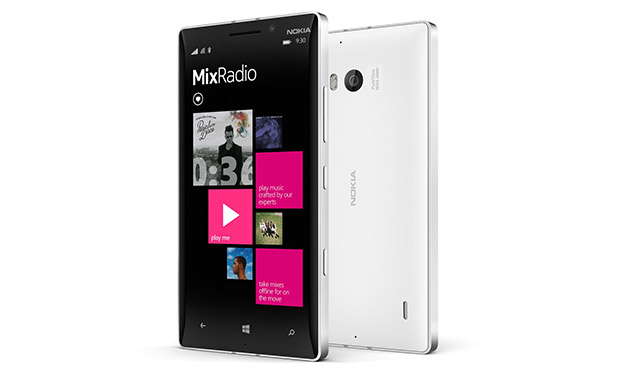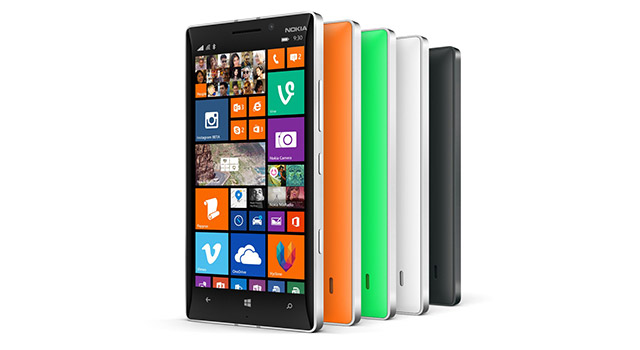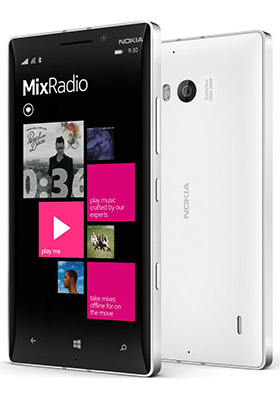
The Nokia Lumia 930 is a superb successor to 2013’s already very good Lumia 925. In terms of design, the 930 can hold its own next to other flagships, including the best from Apple, HTC, Samsung, LG and Sony.
We’ve been fans of Windows Phone for some time. Microsoft, which now owns Nokia, has done a great job creating a fluid, intuitive and beautiful operating system. Despite this, we’ve found it difficult to make the leap, almost exclusively because the application ecosystem is not as rich as Android’s and iOS’s.
That said, Microsoft has made great strides in the past year in attracting new third-party developers to the platform. But there are still gaps.
We’ll get to the software later. Let’s first have a look at the Lumia 930’s hardware.
There’s no doubt that Nokia hit the nail on the head in terms of this phone’s design. There is an aluminium frame that decorates the outside edge of the phone, with a polycarbonate back cover that is available in a range of different colours. These include black, white, bright orange and — why, Nokia, why? — bright green.
The button placement on the right side of the phone remains largely the same as it was on the Lumia 925, but Nokia has tweaked the spacing of the buttons.
These buttons include the volume rocker, power button, and camera button. The 3,5mm audio jack still remains at the top centre of the phone, a great place for it.
The Sim card slot (it takes a nano Sim like the iPhone) is also situated at the top of the phone, and, unlike many other devices, you don’t need a special pin to remove it.

At the heart of the Lumia 930 is a quad-core 2,2GHz Qualcomm Snapdragon 800 processor. There is 2GB of RAM and, although there are no expandable memory card slots, its generous 32GB of flash storage should prove sufficient for most. It comes with 7GB of free Microsoft OneDrive storage.
Nokia has done a great job with the 5-inch LCD display on the Lumia 930. The vivid screen offers full-HD resolution for a pixel density of 441ppi. It’s protected by Corning Gorilla Glass 3, so it’s scratch and crack resistant.
One area where the 930 really shines is the camera. It’s a 20-megapixel Nokia PureView camera capable of producing images at 5 376×3 024 pixels. It has optical image stabilisation (all phones should have this), autofocus and dual-LED flash.

The dedicated camera button on the side of the phone can also be half-pressed to lock focus. The image quality of the shots produced by the Lumia 930 are great. There is a rich colour saturation and the Carl Zeiss optics produce sharp edges on subjects.
The camera can shoot video with stereo sound at 1080p and at 30fps.

There is a front-facing “selfie” camera that produces photographs at 1,2 megapixels and it is able to shoot video at 720p.
The Lumia 930 is slightly heavier than its predecessor, weighing in at 167g, and, at 9,8mm thick, it is not quite as thin as the Lumia 925. But the phone feels solid in the hand and is still not as heavy as some of the other smartphones we have tested this year.
As is to be expected, the 930 packs in the connectivity options. There’s Bluetooth 4.0 support and Wi-Fi support includes dual-band 802.11ac. For 4G/LTE subscribers, the usual array of frequencies are supported, but not Telkom’s 2,3GHz spectrum. Those on Vodacom and MTN will be fine.
The Lumia 930 also has built-in FM radio support and assisted GPS and Glonass support.
It has a non-removable, 2 420mAh battery that delivers around the usual day’s worth of use. Using the Lumia 930 more regularly for video or music sees a drop in battery performance and a second charge during the day may be required for heavy smartphone users.
About the software
Every time that we test a Windows Phone device, we are reminded how great the operating system is, particularly the refined version 8.1.
Windows Phone is a radical departure from the user interfaces that decorate iOS and Android. For that reason alone, it’s worth liking.
Although there are some layout and stylistic changes we’d like to see — especially to make navigation a little easier — the operating system is ideal for new smartphone users or even advanced users.
 The Lumia 930 comes with applications such as the Here Maps and Here Drive+ mapping and navigation tools. Office 365 and OneDrive are also supported out of the box.
The Lumia 930 comes with applications such as the Here Maps and Here Drive+ mapping and navigation tools. Office 365 and OneDrive are also supported out of the box.
There’s also Nokia MixRadio, a free music streaming service that has a paid-for option available to unlock additional features, and Lumia Beamer, a Nokia technology that will allow users to beam their phone’s screen to an Internet-connected display.
Creative photography apps are bundled, too, the most notable of which are Lumia Cinemagraph and Lumia Creative Studio. The former allows users to make cinemagraphs, still images that have moving elements in them. The latter lets users add doodles and other image enhancements to their photos.
While these bundled apps are great, and although the volume of choice in the Windows Phone Store has grown significantly, there are still gaps in the line-up. These include apps such as Simfy Africa, Strava, and Google’s suite of apps, including Hangouts.
Services such as Dropbox have third-party apps that connect to them, but users should be wary of providing their login details to those.
It’s a pity given how much Windows Phone has matured as a platform.
Should app support not be a big consideration, consumers will love what Nokia has produced with its latest smartphone. It’s certainly the best Lumia phone we’ve used to date. Just avoid the green one!
The Lumia 930 retails for about R8 000 without a contract. Some online deals have it for about R1 000 less than that. — © 2014 NewsCentral Media

